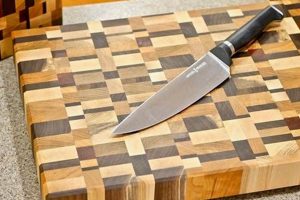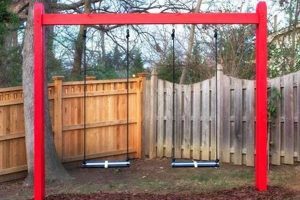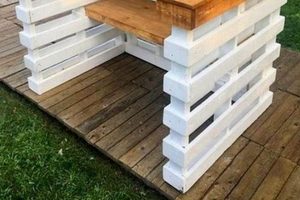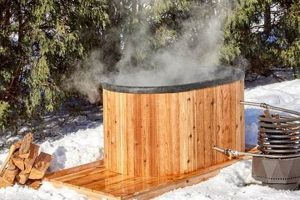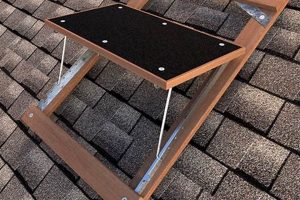Constructions and crafts utilizing reclaimed wooden platforms are a popular method for creating a diverse range of items. These platforms, typically used for shipping and storage, can be disassembled and repurposed into furniture, decorative pieces, and structural elements. Examples include constructing coffee tables, building vertical gardens, and creating accent walls.
The practice offers several advantages, including cost savings through the use of readily available materials and environmental benefits through recycling and repurposing. Historically, using recovered materials has been a common practice, evolving alongside trends emphasizing sustainability and resourcefulness. This approach minimizes waste and offers individuals a way to engage in creative expression with readily available resources.
The following sections will delve into specific design considerations, safety precautions, and practical techniques for working with reclaimed wood platforms, providing a guide to successful project completion.
Essential Guidance for Reclaimed Wood Platform Endeavors
Employing reclaimed wooden platforms in construction requires careful consideration of material properties, design constraints, and appropriate safety measures to ensure project durability and user safety.
Tip 1: Material Selection: Prioritize platforms bearing the “HT” (heat treated) stamp, indicating treatment for pest control without harmful chemicals. Avoid those marked “MB” (methyl bromide), as this is a toxic fumigant.
Tip 2: Thorough Inspection: Scrutinize each platform for structural integrity, identifying cracks, splits, rot, or signs of insect infestation. Discard any compromised elements to prevent project failure and potential hazards.
Tip 3: Proper Disassembly: Employ suitable tools such as reciprocating saws or specialized pry bars designed for nail removal to dismantle the platforms without damaging the wood. Wear appropriate safety gear, including eye protection and gloves.
Tip 4: Comprehensive Cleaning: Thoroughly clean each board with a stiff brush and a solution of soap and water to remove dirt, debris, and potential contaminants. Allow the wood to dry completely before commencing any sanding or finishing processes.
Tip 5: Precise Sanding: Sand the reclaimed wood platform surfaces to achieve a smooth, uniform texture. Start with a coarse grit sandpaper to remove imperfections and progress to finer grits for a polished finish.
Tip 6: Appropriate Sealing: Apply a sealant or finish appropriate for the intended use of the project. Consider moisture resistance for outdoor applications and food-safe finishes for items intended for kitchen use.
Tip 7: Secure Fastening: Utilize screws designed for woodworking rather than nails to ensure secure and durable connections. Pre-drill pilot holes to prevent wood splitting during assembly.
Adhering to these guidelines will contribute to the successful creation of aesthetically pleasing and structurally sound items from reclaimed wooden platforms.
The final section will address common challenges encountered in reclaimed wood platform projects and strategies for effective problem-solving.
1. Material Sourcing
The acquisition of suitable wooden platforms is a foundational element in the success of any reclaimed wood endeavor. Responsible and informed material procurement directly impacts project safety, aesthetic outcome, and environmental sustainability.
- Treatment Verification
Wooden platforms are frequently subjected to chemical treatments for pest control and preservation. Platforms marked with “HT” (heat treated) are generally considered safer than those treated with chemicals like methyl bromide (“MB”), which poses significant health risks. Verifying the treatment method before acquisition is essential for user safety.
- Structural Assessment
Prior to use, each platform should undergo a rigorous structural assessment. Identifying and rejecting platforms exhibiting signs of rot, significant cracking, or insect infestation is critical. Using compromised materials can jeopardize the integrity of the final product and create unsafe conditions.
- Source Validation
Understanding the origin of wooden platforms is vital. Platforms sourced from industries handling hazardous materials may be contaminated. Verifying the original use of the platform helps minimize exposure to potentially harmful substances. Sourcing from reputable suppliers can provide more detailed information on platform handling and previous use.
- Sustainable Procurement
Embracing the practice inherently promotes environmental responsibility. Prioritizing platforms destined for landfill diverts waste and reduces demand for newly harvested lumber. Sourcing from local businesses or recycling centers further minimizes the environmental impact of transportation and supports community-based waste reduction efforts.
Careful platform acquisition practices significantly enhance the safety, durability, and sustainability of resulting structures. The diligence exercised in material selection directly reflects the quality and longevity of completed projects.
2. Design planning
Effective design planning is a fundamental prerequisite for successful repurposed wood platform constructions. This phase dictates material requirements, determines structural feasibility, and mitigates potential safety hazards inherent in working with reclaimed resources. A lack of comprehensive design considerations often results in material waste, unstable constructions, and projects that fail to meet their intended purpose. For example, a poorly planned coffee table project may lack sufficient support, leading to structural collapse under minimal weight. Conversely, meticulous planning ensures optimal material utilization, yielding a durable and aesthetically pleasing finished product. Therefore, design planning is not merely an advisory step but an essential component influencing the success of any building project.
Detailed design sketches, coupled with precise measurements, facilitate accurate material calculations and minimize cutting errors. The selection of appropriate joinery techniques, such as mortise-and-tenon or dovetail joints, during the planning stage significantly contributes to the overall strength and stability of furniture. Additionally, the design must incorporate considerations for wood grain orientation, expansion, and contraction, particularly in environments with fluctuating humidity levels. Furthermore, surface treatment such as staining, varnishing should be integrated into the design plan. These considerations prevent warping or joint failure over time. Practical application of design principles includes detailed drafting, 3D modeling or simple hand sketches.
In summary, robust design planning functions as the cornerstone of successful repurposed wood platform projects. A proactive approach to this phase mitigates risks, optimizes material use, enhances structural integrity, and ensures the final product aligns with its intended function. The challenges associated with sourcing and repurposing reclaimed wood platforms are effectively addressed through careful design, transforming potentially problematic materials into functional and aesthetically valuable objects. The integration of design planning into the process promotes sustainable practices by reducing waste and enhancing the lifespan of repurposed materials, contributing to resource efficiency.
3. Safety protocols
The successful execution of reclaimed wood platform projects necessitates a stringent adherence to safety protocols. Reclaimed wood often presents hazards not typically encountered with new lumber, including embedded fasteners, chemical treatments, and biological contaminants. Neglecting appropriate precautions can result in injury or long-term health complications.
- Personal Protective Equipment (PPE)
The consistent use of PPE is essential. Safety glasses or goggles provide critical eye protection against flying debris during cutting, sanding, and disassembly. Heavy-duty work gloves safeguard hands from splinters, rough surfaces, and potential punctures. A respirator or dust mask minimizes inhalation of wood dust, mold spores, and potentially harmful chemicals released during sanding and cutting.
- Tool Handling and Maintenance
Power tools used in wood platform projects, such as saws and sanders, demand strict adherence to manufacturer guidelines. Regular inspection of power cords, blades, and safety guards is crucial. Disconnecting power tools when changing blades or performing maintenance prevents accidental activation. Ensuring adequate workspace lighting and maintaining a clean work area minimizes the risk of trips and falls.
- Hazardous Material Awareness
Reclaimed wood platforms may have been treated with chemicals for pest control or preservation. Identifying treatment stamps (e.g., “HT” for heat-treated, “MB” for methyl bromide) is vital. Wood treated with methyl bromide should be avoided due to its toxicity. When unsure of the treatment method, assume a potential hazard and wear appropriate respiratory protection. Proper disposal of waste materials, including sawdust and sanding debris, prevents environmental contamination.
- Structural Integrity Assessment
Before disassembly, each platform must be assessed for structural soundness. Rotten, cracked, or insect-infested wood poses a significant safety risk. Attempting to work with compromised materials can lead to collapse or structural failure during the project. Damaged components should be discarded responsibly, minimizing the risk of injury to oneself or others.
Integrating comprehensive safety protocols into every phase of reclaimed wood platform endeavors reduces the likelihood of accidents and ensures a safer working environment. Prioritizing safety demonstrates a commitment to responsible craftsmanship and promotes sustainable practices by preserving health and well-being while repurposing valuable resources.
4. Disassembly methods
The process of deconstructing wooden platforms significantly impacts the quality and usability of reclaimed materials for project construction. Employing proper disassembly techniques directly affects the integrity of individual boards and the overall efficiency of material recovery. Inefficient or forceful methods often lead to splitting, cracking, or splintering of the wood, thereby reducing the yield of usable components and increasing material waste. For instance, using a hammer and brute force to remove nails can cause significant damage compared to utilizing a specialized pry bar designed to extract fasteners with minimal impact. The selection of appropriate tools and techniques is therefore a crucial determinant of success in wooden platform projects.
Different disassembly methods cater to varying platform construction styles and fastener types. Platforms secured with nails typically benefit from the use of pry bars, reciprocating saws with metal-cutting blades, or nail pullers. In contrast, platforms assembled with screws necessitate the use of screwdrivers or power drills, ideally with torque control to prevent stripping the screw heads. The choice of technique influences the speed and ease of disassembly, as well as the potential for damaging the reclaimed wood. Consider a project involving the creation of rustic shelving from reclaimed platforms: proper disassembly ensures that the planks retain their original dimensions and surface texture, enhancing the aesthetic appeal of the finished product. Ineffective methods may render the wood unusable, requiring additional processing or replacement with new materials.
In summary, the effectiveness of disassembly methods directly correlates with the quality and quantity of reusable materials obtained for wooden platform endeavors. Implementing correct techniques minimizes damage, reduces waste, and maximizes the value of reclaimed wood. Understanding the diverse array of disassembly tools and strategies empowers constructors to optimize material recovery and achieve superior results. The careful application of these methods significantly contributes to the sustainability and cost-effectiveness of working with reclaimed resources, furthering the core principles of resourcefulness in the DIY context.
5. Finishing techniques
The application of finishing techniques is a critical step in the successful transformation of reclaimed wood platforms into functional and aesthetically pleasing items. These processes not only enhance the visual appeal of the wood but also provide protection against environmental factors, extending the lifespan of the completed project.
- Surface Preparation
Before any finishing product is applied, meticulous surface preparation is essential. This involves sanding the wood to a smooth, uniform texture, removing any splinters, and filling any gaps or imperfections. Failure to adequately prepare the surface can result in uneven finish absorption and a less than desirable final appearance. Surface preparation significantly influences adhesion and appearance of subsequent coatings.
- Sealing and Priming
Applying a sealant or primer before the final finish coat serves to block tannins and resins present in the wood, preventing discoloration or staining of the topcoat. Sealants also help to create a uniform surface for the finish to adhere to, improving durability and longevity. Priming is particularly important when using light-colored paints or stains, as it prevents the natural wood color from bleeding through.
- Protective Coating Application
The choice of protective coating is contingent upon the intended use and exposure conditions of the project. For indoor furniture, options include polyurethane, varnish, lacquer, and wax. Exterior projects necessitate coatings with UV inhibitors and water resistance, such as spar varnish or exterior-grade polyurethane. Proper application techniques, including multiple thin coats with adequate drying time between applications, ensure optimal protection and durability.
- Aesthetic Enhancement
Finishing techniques can also be used to enhance the aesthetic appeal of wood platform constructions. Staining alters the wood’s color, highlighting the grain and adding depth. Distressing techniques, such as sanding edges or applying antiquing glazes, can create a rustic or weathered look. The skillful application of these techniques can transform reclaimed wood into pieces of character.
In essence, the effective application of finishing techniques elevates the transformation of reclaimed wood platforms from simple construction projects to refined pieces of craftsmanship. By carefully considering surface preparation, sealing, protective coatings, and aesthetic enhancements, practitioners can achieve both functional and visually appealing results.
6. Structural integrity
Structural integrity is paramount in the context of reclaimed wood platform constructions, influencing the longevity, safety, and functionality of the final product. Failure to adequately address structural considerations can result in unstable structures, posing risks to users and compromising the intended purpose.
- Material Assessment
The inherent strength and condition of reclaimed wood platform components directly impact structural stability. Pre-existing cracks, rot, insect damage, or chemical degradation compromise load-bearing capacity. Comprehensive material assessment, including visual inspection and load testing, is essential to identify and discard unsuitable components, mitigating the risk of structural failure in service. For example, using rotted wood for a load-bearing table leg can lead to collapse. Such material assessment dictates the initial stages of project planning, affecting the type and scale of endeavor undertaken.
- Joint Design and Execution
The selection and implementation of appropriate joinery techniques are pivotal in maintaining structural integrity. Weak or improperly executed joints are prone to failure under stress. Considerations must be given to the direction of applied forces, the properties of the wood, and the long-term stability of the connections. Options range from mortise and tenon, dovetail, or simple butt joints reinforced with metal fasteners. Consider a large bookshelf constructed using butt joints alone; the shelf would likely sag under the weight of books, whereas dovetail joints better distribute the load.
- Load Distribution and Support Systems
An understanding of load distribution is critical for designing structures that can withstand anticipated forces. Concentrated loads must be adequately supported by appropriately sized and positioned structural members. Reinforcements, such as bracing or additional supports, may be necessary to prevent deformation or collapse. Building a platform bed without sufficient support beams will result in sagging, while strategic reinforcement distributes weight evenly, ensuring a stable surface.
- Environmental Factors and Material Behavior
Environmental factors, such as moisture and temperature fluctuations, influence the behavior of wood, leading to expansion, contraction, and potential joint failure. Incorporating design considerations that account for these effects is essential for long-term structural stability. Employing weather-resistant finishes and allowing for expansion gaps mitigates the risk of warping, cracking, or joint separation in outdoor applications. A park bench constructed without accounting for these factors might develop cracks and loose joints with seasonal changes.
Therefore, structural integrity is not simply a consideration, but an essential requirement for any successful endeavor utilizing reclaimed wooden platforms. From initial material selection to joinery, load distribution, and environmental factors, a comprehensive approach to structural design is vital for creating safe and durable constructions.
Frequently Asked Questions About Building With Reclaimed Wood Platforms
The following addresses prevalent inquiries regarding the utilization of reclaimed wood platforms, providing guidance on safety, material selection, and construction techniques.
Question 1: What are the primary safety considerations when working with reclaimed wood platforms?
Reclaimed wood platforms may harbor hidden dangers, including embedded nails, chemical treatments, and biological contaminants. Protective gear, such as gloves, safety glasses, and respirators, is essential. Materials must be thoroughly inspected and cleaned to mitigate potential risks.
Question 2: How does one identify potentially harmful chemical treatments on wood platforms?
Wood platforms are often marked with stamps indicating treatment methods. “HT” signifies heat treatment, generally considered safe. “MB” indicates methyl bromide fumigation, a toxic substance that should be avoided. Unmarked platforms should be treated with caution.
Question 3: What are the most effective methods for disassembling wood platforms?
Disassembly methods vary depending on the type of fastener used. Pry bars, reciprocating saws, and specialized nail pullers are suitable for removing nails. Screws require appropriate screwdrivers or power drills. The goal is to extract fasteners without damaging the wood.
Question 4: What types of finishes are recommended for reclaimed wood platform projects?
Finish selection depends on the intended use of the project. Interior projects may benefit from polyurethane, varnish, or wax. Exterior projects necessitate weather-resistant finishes with UV inhibitors, such as spar varnish or exterior-grade polyurethane. Food-safe finishes are required for items intended for kitchen use.
Question 5: How can structural integrity be ensured in projects utilizing reclaimed wood platforms?
Thorough material assessment, proper joint design, and adequate load distribution are crucial. Cracked, rotted, or infested wood should be discarded. Joinery techniques, such as mortise and tenon or dovetail joints, enhance stability. Reinforcements may be necessary to support concentrated loads.
Question 6: What are the environmental benefits associated with using reclaimed wood platforms?
Repurposing wood platforms reduces waste, diverts materials from landfills, and decreases demand for newly harvested lumber. It also minimizes the environmental impact associated with manufacturing and transporting new wood products.
Adhering to these guidelines enhances the safety, durability, and sustainability of projects employing reclaimed wood platforms.
The subsequent section addresses advanced techniques in working with reclaimed wood platforms.
diy wood pallet projects
The preceding sections have illuminated critical facets of utilizing reclaimed wood platforms for various construction and design endeavors. From material sourcing and safety protocols to design considerations and finishing techniques, a comprehensive understanding of these elements is essential for project success. Emphasis has been placed on responsible material acquisition, proper disassembly procedures, and the importance of maintaining structural integrity to ensure safe and lasting constructions.
Continued exploration of innovative approaches and refinement of existing methodologies will further enhance the value and applicability of reclaimed wood platforms. A commitment to sustainable practices, coupled with rigorous attention to detail, will solidify the position of diy wood pallet projects as a viable and responsible option for both amateur and professional builders. The future of this practice hinges on informed execution and a dedication to minimizing environmental impact through responsible resource management.


